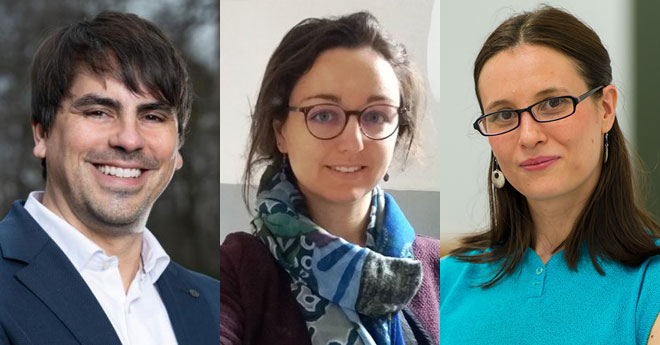Accommodating differing expectations
Dr Barbara McGillivray (King’s College London) recalls working on “The Language of Mechanisation” (youtube.com) – a project at the intersection of history, computational linguistics, data science, library science and research software engineering.
“The idea for this project came from the realisation that, to make the most of large textual datasets and answer historical questions with them, we need to have computational linguists and data scientists working together with historians. This is an area that is still quite niche in the digital humanities, but it is expanding quickly, thanks to increasingly large datasets available in digital form.
The benefits of working in a highly interdisciplinary team are that we get a wide range of ideas for experimentation, many of which would not even be conceived if we worked in a mono-disciplinary environment. However, there are certainly many challenges. For example, historians are used to publishing single-authored articles, which is a type of publication that doesn’t suit collaborative work, and the publication procedures tend to be quite long. On the other hand, computational linguists are used to publishing multi-authored articles at a fast pace.
The people I ended up working with were very open-minded and easy to collaborate with. Still, I’d say the biggest challenge we faced was the difference in expectations. What counts as an innovative contribution in computational linguistics, for example, is often a new algorithm, while in history the focus is more on the insights rather than on the methodology. We ended up producing publications that had different foci (more methodological or more theoretical) to suit the expectations of the different disciplines involved."
I was thrilled to discover that Circle U. offered us an opportunity to submit our project to be considered for the award. It would be great to have more opportunities to support interdisciplinary researchers, for example via this and other similar award programmes.
– Dr Barbara McGillivray
Communication is key
“Towards Sustainable Fisheries" (youtube.com)” got local and regional stakeholders on board to answer ecological and sociao-economic questions. Professor Dr Robert Arlinghaus (Humboldt-Universität zu Berlin) explains what it took to make it a success.
“My goal has always been to solve problems which fisheries managers face on the ground. Inter- and transdisciplinarity is the only way you can do that because fishery, by definition, is a human endeavor. To understand it, you need insights from both social and ecological science - as well as strong stakeholder involvement. That’s why, in fisheries, many people talk about interdisciplinarity - but in reality, few actually go for it. In a sense, we were pioneers. I am not aware of similarly large-scaled stakeholder-inclusive experiments with real ecosystems in the field of inland fisheries.
When you work across disciplines, you need a common framework and deal with different expectations. Interdisciplinarity is not for everybody. You have to want it. You must have the passion to solve the applied project and to bring disciplines and stakeholders together. You must have an honest interest in being a knowledge broker and be good at communication.
The people on my team were either my former students or new hires. The biggest challenge was integration and finishing PhD projects in time with so much stakeholder communication involved. We were lucky that the German Federal Ministry of Education and Research published two long-term projects for a duration of five to six years; that’s how long our project ran."
We need more traditional universities to acknowledge inter- and transdisciplinary work. In this regard, the ICUP award and the public recognition through Circle U. is very useful.
– Professor Dr Robert Arlinghaus
Making time to go the distance
Dr Manon Bajard (University of Oslo) was part of “VIKINGS: Volcanic Eruptions and Their Impacts on Climate, Environment and Viking Society” (youtube.com). For her, working across multiple disciplines required physical as well as mental movement.
“Ten years ago, when I started my career in paleoenvironment reconstruction and socio-environmental dynamics, interdisciplinary research was already common in the field – and it has become even more so since. It helps us bring together all the puzzle pieces to form a more complete picture of our research subjects. The work may be more complicated and time-demanding, but the results are worth it.
Firstly, interdisciplinarity is more complicated because our existing research and education infrastructures were built in such a way that people from different disciplines often sit in different buildings, maybe not even on the same campus. So, we have to meet up formally to discuss our questions and ideas - you can't just drop by your colleague’s office.
Secondly, because of that distance, different cultures of research have formed. There are, for example, large differences between natural and social sciences in terms of publication strategies or team work. You need to understand and adapt to their respective codes and learn the basics of your colleagues’ fields to be able to work together.
I was hired on the VIKINGS project with several other early career researchers (PhDs, postdocs, students) and this ‘junior’ group tried to meet on a weekly basis to learn more about each other’s work and discuss what we could bring to one-another. I think this was key to the functioning of our cooperation.
In general, inter- and transdisciplinary projects take more time, because you depend on other people to build the framework and do the research. So, you need longer-term contracts and more money to realise such projects – and funding is always difficult to get!"
Circle U. has the potential to help spread more information about work done at the different universities, facilitate new collaborative projects and support pluridisciplinarity in higher education.
– Dr Manon Bajard
 |
Subscribe to the monthly Circle U. newsletter. |
